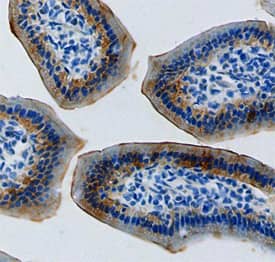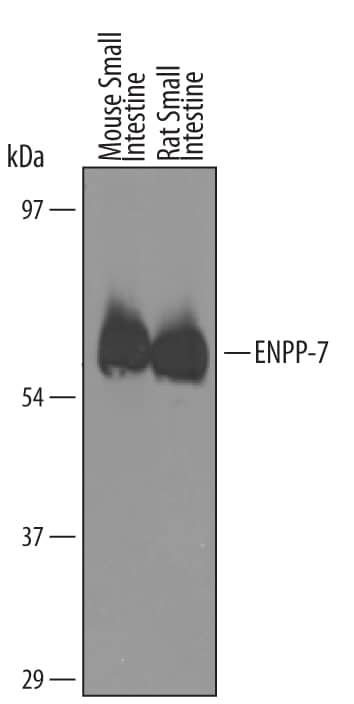Mouse ENPP-7/Alk-SMase Antibody
R&D Systems, part of Bio-Techne | Catalog # AF5160


Key Product Details
Species Reactivity
Applications
Label
Antibody Source
Product Specifications
Immunogen
Ala22-Gln421
Accession # NP_001025462
Specificity
Clonality
Host
Isotype
Scientific Data Images for Mouse ENPP-7/Alk-SMase Antibody
ENPP‑7/Alk-SMase in intestine.
ENPP-7/Alk-SMase was detected in perfusion fixed frozen sections of mouse intestine using Mouse ENPP-7/Alk-SMase Antigen Affinity-purified Polyclonal Antibody (Catalog # AF5160) at 15 µg/mL overnight at 4 °C. Tissue was stained using the Anti-Sheep HRP-DAB Cell & Tissue Staining Kit (brown; Catalog # CTS019) and counterstained with hematoxylin (blue). View our protocol for Chromogenic IHC Staining of Frozen Tissue Sections.Detection of Mouse ENPP-7/Alk-SMase by Western Blot.
Western blot shows lysates of mouse small intestine tissue and rat small intestine tissue. PVDF membrane was probed with 1 µg/mL of Mouse ENPP-7/Alk-SMase Antigen Affinity-purified Polyclonal Antibody (Catalog # AF5160) followed by HRP-conjugated Anti-Sheep IgG Secondary Antibody (Catalog # HAF016). A specific band was detected for ENPP-7/Alk-SMase at approximately 60kDa (as indicated). This experiment was conducted under reducing conditions and using Immunoblot Buffer Group 8.Applications for Mouse ENPP-7/Alk-SMase Antibody
Immunohistochemistry
Sample: Perfusion fixed frozen sections of mouse intestine
Immunoprecipitation
Sample: Conditioned cell culture medium spiked with Recombinant Mouse ENPP-7/Alk-SMase (Catalog # 5160-EN), see our available Western blot detection antibodies
Western Blot
Sample: Mouse small intestine tissue and rat small intestine tissue
Formulation, Preparation, and Storage
Purification
Reconstitution
Formulation
Shipping
Stability & Storage
- 12 months from date of receipt, -20 to -70 °C as supplied.
- 1 month, 2 to 8 °C under sterile conditions after reconstitution.
- 6 months, -20 to -70 °C under sterile conditions after reconstitution.
Background: ENPP-7/Alk-SMase
ENPP7 (ectonucleotide pyrophosphatase/phosphodiesterase 7), also known as alkaline sphingomyelinase (Alk-SMase) is expressed in the intestines and in bile (1). It shares 30-36% homology with the members of the nucleotide pyrophosphatase/phosphodiesterese (NPP) family while sharing no similarities with neutral or acid SMase (2). Its main function is the digestion of dietary sphingomyelin by hydrolyzing sphingomyelin into ceramide and phosphorylcholine. ENPP7 is reported to hydrolyse and inactivate platelet-activating factor (PAF) by a phospholipase C-type activity (3). Studies show a decrease in ENPP7 activity in human colorectal adenocarcinomas and human colorectal carcinomas, which indicate a potential role of ENPP7 in human colon cancer (4, 5).
References
- Duan, R-D. et al. (2006) Biochim. Biophys. 1761:281.
- Duan, R-D. et al. (2003) J. Biol. Chem. 278:38528.
- Wu, J. et al. (2006) Biochem J. 394:299.
- Hertervig, E. et al. (1996) Cancer. 79:448.
- Hertervig, E. et al. (1999) Br. J. Cancer. 81:232.
Long Name
Alternate Names
Gene Symbol
UniProt
Additional ENPP-7/Alk-SMase Products
Product Documents for Mouse ENPP-7/Alk-SMase Antibody
Product Specific Notices for Mouse ENPP-7/Alk-SMase Antibody
For research use only
